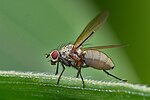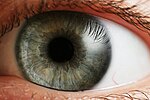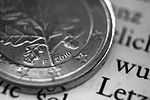Macro photography

In macro photography , an object is positioned in front of the camera in such a way that it is reproduced very large and in great detail on the picture. In the narrower sense, one speaks of macro photography when the image of the object on the camera sensor appears as large as the object itself; the image scale is then exactly 1, also shown as 1: 1. This is also the maximum image scale often found with macro lenses . Photography with larger image scales, in which the object on the film (or, in the case of digital cameras, the sensors) is shown much larger, is called microphotography . In the DIN 19040 standard, everything in the scale range between 1:10 and 10: 1 counts as close-up or macro photography.
Tools
Normal lenses are often constructed with an image scale of 1:10. A bellows device or an intermediate ring must be used to image larger .
Since the image in the optical calculation of the lens is not corrected for the near range, the imaging performance improves if the lens is operated in reverse . The lens is usually screwed onto its front filter thread with a coupling ring.
Bellows device
The most original method is to use a bellows device, which is mounted between a normal lens and the camera body on a single lens reflex camera. Some older cameras and some medium-format cameras already have such a bellows built in, with view cameras the wide adjustability of the lens extension is standard. The adjustment by bellows is infinitely variable and can usually be combined with different lenses.
Magnifying lenses have also proven their worth as lens heads on bellows devices , since they are calculated for short distances. As a rule, an adapter from the bellows device (e.g. M-42 or bayonet) to M-39 - the common connection for enlargers - is required.
Intermediate rings
Intermediate rings are an alternative to the bellows device. They work according to the same principle, but the setting range is limited by the specified length. Intermediate rings are usually offered in sets of three different lengths that can be combined with one another. It is advantageous that the transmission of automatic lens functions is possible with most camera systems. In the case of bellows devices, the transmission of mechanical functions, in particular, is much more complex and expensive due to the infinitely variable adjustability. Spacer rings are particularly suitable for lenses with a fixed focal length. Depending on the design, there may be problems with focusing with zoom lenses. The minimum distance of telephoto lenses can also be reduced very well. This allows a high reproduction ratio with a large distance to the subject, which is particularly advantageous in animal photography.
Close-up lenses
Close-up lenses are lens attachments that can be screwed into the filter thread of a lens. The power of a close-up lens is given in diopters . In direct comparison to macro lenses , the optical quality and ease of use are generally lower. High-quality close-up lenses are designed as achromatic lenses , for some macro lenses there are also specially adapted additional lenses that hardly impair the imaging performance. Close-up lenses also lengthen the lens extension, but not mechanically, but by shortening the actual focal length of the lens used. In contrast to the use of intermediate rings or bellows devices, no exposure correction has to be taken into account. Image scales of up to about 1: 4 can be achieved in good quality with close-up lenses; in addition, the image performance usually decreases significantly, especially in the edge area.
With the aid of coupling rings or coupling rings, photo lenses, preferably bright, approximately symmetrical types such as a close-up lens, can be used. The objective used as a close-up lens should be compact and light, both objectives should have the filter thread on the fixed tube, because mechanical damage due to excessive mechanical loads is otherwise not unlikely.
Retro adapter
Lenses in retro position allow macro photography - just like close-up lenses - without complex technical equipment. You need an adapter, also known as an inverting ring , with which an interchangeable lens can be attached upside down to the lens connection of a reflex camera.
The adapter is screwed into the filter thread of the lens on one side and fits into the bayonet or screw connection of the camera on the other side. It does not matter whether the lens belongs to a different bayonet, as the bayonet is not connected to the camera. Lenses that have manual adjustment options for the aperture are useful. Depending on the lens, normal and wide-angle lenses with fixed focal lengths are then possible - images on a scale of 1: 1 and magnifications. The combination with intermediate rings and bellows devices for particularly strong enlargements is also possible. The image quality of a single lens in the retro position is often higher than that of a lens that is used in the normal position with spacer rings or a bellows device, but it depends on the construction of the lens. The advantage is that with a lens in the retro position, a fairly large distance between the subject and the camera can be maintained; it corresponds roughly to the distance between the film plane and the rear camera lens when the lens is normally used ( flange focal length ) and is therefore depending on lenses for 35mm SLR cameras according to manufacturer at approx. 4–5 cm. The disadvantage is the loss of almost all automatic functions of the camera (with some cameras the automatic exposure control (aperture priority / aperture priority) can still be used) if no cost-intensive special adapter is available: the aperture position and spring aperture must be operated by hand, the focus is and backward movement of the camera or bellows adjustment. In addition, the sensitive mechanics of the back of the lens are exposed. Adapters are available for fully electrically controlled lenses that contain all the automatic functions for aperture control.
Macroscopes
The centric beam path of the variable iris diaphragm makes macroscopes ideal for demanding photography of small objects with a relatively large working distance. Due to their design, the macroscopes are special reflected light photomicroscopes for low magnification ranges. They are not part of the classic stereo microscope , as they do not contain two beam paths. Often these devices are also equipped with binocular tubes for observation so that the impression of a stereo microscope is created. The image scale ranges from 1: 2 to 100: 1 with a working distance of approximately 150 mm to 30 mm. They are always provided with a variable iris diaphragm to control the optimal depth of field. In contrast to stereo microscopes, the image quality is higher and the image scale can be changed, but a spatial image impression (“stereo effect”) is not possible.
Close range formulas
The formula for the light intensity of a lens applies to objects at infinity and must be modified for the macro range. Because if the camera approaches the object, it becomes larger and therefore less light. For the aspect ratio 1: 1 (or A = 1; see lens equation ) the image distance is exactly twice as large as the focal length and the luminosity of the image drops to a quarter. In macro photography, the focal length f can be replaced by the image distance b in the formulas for light intensity and image angle . In the table, this difference between the effective light intensity and the effective angle of view is shown more clearly with the magnification factor A:
| Distance ∞ | Close range |
|---|---|
| nominal light intensity | effective light intensity |
| Angle of view: | effective angle of view: |
Variables derived from the effective values - such as the exposure time required for correct exposure, which results from the effective light intensity and the subject brightness - are also given the addition "effective" , in this case effective exposure time . It results from the exposure time B (not the effective one )
Macro shot
layout
When designing macro photographs, it must be taken into account that the depth of field is very small at close range. Although stopping down strongly increases the sharpness range, diffraction effects can easily lead to a reduction in general sharpness. The choice of the focal plane on the object thus significantly determines the overall design impression. In the case of immobile subjects, focus stacking allows the focus area to be enlarged.
Examples
Snapshot of a fly (Brachycera )
Catkins in the rain
Stink bug clutch on a copper beech leaf ; Close-up lens
Head of a stink bug on a 1: 8 scale
literature
- Enrico Savazzi: Digital Photography for Science - Close-up Photography, Macrophotography, and Photomacrography , ISBN 978-0-557-92537-7 (paperback), ISBN 978-0-557-91133-2 ( hardback ), Lulu-Verlag , 2011























